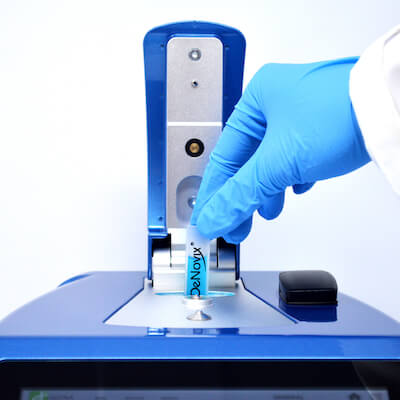What is DNA quantification?
DNA quantification is a fundamental laboratory process that enables the accurate analysis of genetic samples.
Broadly speaking, DNA quantification is any process used to determine the concentration of DNA in a sample. Usually carried out before downstream experiments, DNA quantification is vital in ensuring the validity of experimental results.
How is DNA quantification carried out?
There are several different techniques by which DNA quantification can be carried out. Some of these (such as UV-Vis spectrophotometry) require no modification of the sample, while many others (such as fluorometry techniques) involve staining or dyeing the sample with molecular markers to enable more detailed inspection.
The best choice for a given application depends on many factors, including the required degree of accuracy, capital expenditure on equipment and cost of consumables.1,2
1. UV-Vis Spectrophotometry
UV-Vis spectrophotometry (or closely-related UV spectrometry) is one of the most common methods of DNA quantification. It measures the absorption or transmission of frequencies of light in the ultraviolet and visible regions of the spectrum.
Comparing the absorption / transmission profiles of a “blank” reference solution (consisting of the buffer that the DNA is suspended in) and that of the DNA sample enables rapid and straightforward DNA quantification. Advantages of spectrophotometric techniques include the speed of analysis, low cost and direct measurement of the sample so no standards are required. UV-Vis analysis also provides information on potential contamination due to protein or co-extracted salts.
2. Fluorometry
Fluorometric DNA quantification techniques rely on the use of molecular dyes, which preferentially bind to DNA molecules. Typically, these dyes (such as PicoGreen or SYBR Green) are specific to double-stranded DNA, while UV-Vis DNA quantification methods don’t discriminate between RNA and DNA.
After preparing the fluorescence assay, DNA quantification is carried out using a fluorometer, which compares the fluorescence of a given sample to a standard curve and a set of DNA samples of known concentration.
Fluorometric techniques are more sensitive than absorbance-based methods such as UV-Vis DNA quantification, making them more suitable for measuring low concentrations of DNA and are more specific for the analyte of interest.
3. Real-time quantitative polymerase chain reaction (PCR)
In and of itself, polymerase chain reaction (PCR) is a technique for DNA amplification rather than necessarily quantification. It involves repeated thermal cycling of DNA samples and the use of high-temperature DNA polymerase enzymes to replicate target DNA sequences.
Real-time PCR or quantitative PCR (qPCR) techniques combine DNA amplification with DNA quantification to enable the calculation of the concentration of DNA sequences in the initial sample.3 Many different variations of qPCR have been developed, and a variety of qPCR kits are available for labs to purchase. Technically most qPCR techniques are a subset of fluorometry, relying on fluorescent dyeing to quantify double-stranded DNA or specific DNA sequences of interest.
4. Gel electrophoresis
Electrophoresis is a method for the separation of macromolecules – such as DNA, RNA and proteins – by size and / or charge. First, a DNA sample is deposited on a matrix such as an agarose gel. An electric field is applied to the gel, causing the DNA molecules to migrate across it. Because smaller molecules move through the porous gel more easily than longer molecules, the DNA fragments in the sample naturally separate according to their length, producing “bands” consisting of DNA fragments of specific sizes.
For DNA quantification, the intensity of these bands can be used to determine the concentration of a given DNA fragment in the initial sample. This method of DNA quantification can indicate DNA or RNA contamination based on the presence of certain bands or streaking. This method is generally more time-consuming than spectrophotometry or fluorescence quantification and less accurate in terms of quantification but will provide information on size distribution of DNA fragments.
5. Capillary electrophoresis
Capillary electrophoresis works similarly to gel electrophoresis, except the separation is carried out within a thin capillary rather than on a bed of gel. The process is also typically automated.
Because this DNA quantification technique is carried out in a capillary tube, it requires only a minimal amount of sample: typically around 1 – 2 μL. As fragments move through the capillary tube and are separated by length, an intercalating dye is used to quantify fragments in order of length.
DNA quantification solutions from DeNovix
DeNovix is a world-leader in DNA quantification. The DeNovix DS-11 Series combines both absorbance and fluorescence in a single instrument to provide high precision, sensitivity specificity and ease-of-use. In addition, a full range of DNA & RNA assays provide simple mix-and-measure solutions with the widest dynamic range available.
To find out more about our DNA quantification solutions, get in touch with a member of the DeNovix team today.



